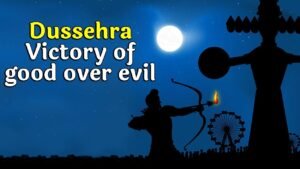Things you need to know about Hindu festival “Dussehra”
What is Dussehra in Hinduism?
Dussehra, also called Dasara or Vijayadashami, in Hinduism, holiday marking the triumph of Rama—an avatar of lord Vishnu— over the 10-headed demon king Ravana, who abducted Rama’s wife, Sita. The festival’s name is derived from the Sanskrit words dasha (“ten”) and hara (“defeat”).

When do the Hindu Community celebrate this festival?
Symbolizing the victory of good over evil, Dussehra is celebrated on the 10th day of the month of Ashvina (September–October), the seventh month of the Hindu calendar, with the appearance of the full moon, an event called the “bright fortnight” (shukla paksha).
Dussehra coincides with the culmination of the nine-day Navratri festival and with the tenth day of the Durga Puja festival. For many, it marks the beginning of preparation for Diwali, which occurs 20 days after Dussehra.
How is this festival celebrated?
Dussehra is celebrated with great fervour and fanfare. It is celebrated in Hindu community across the globe. In various parts of the subcontinent, it incorporates Ram Lila, a gala theatrical enactment of Rama’s life story. However, Effigies of Ravana—often along with those of Meghnada (Ravana’s son) and Kumbhkarana (Ravana’s brother)—are stuffed with firecrackers and set ablaze at night in open fields.

Tonsure / Mundan Ceremony
Moreover, on the eve of Dussehra, the mundan (tonsure) ceremony is done in which mother of a child between four months to three years is seated in front of the holy pyre with the child in her lap. While some families prefer to celebrate the ceremony at home. The priest shaves off a part of the child’s hair. It’s a first haircut of a child which takes place on this ceremony.
It is celebrated among Sindhi Hindus across the world. The ceremony is believed to rid the baby of any negativity from their past life while promoting mental and spiritual development. The demonstration of the ceremony has shown in the picture shared below:

Explaining the importance of the Hindu festival Dussehra
The 10-Headed demon, Ravan is portrayed by his following attributes which is meant to vanish and re-purify one’s soul
1. Kama vasana ( Lust ).
2. Krodha ( anger).
3. Moha ( attachment).
4. Lobha ( greed ).
5. Mada ( over-pride ).
6. Matsara ( jealousy).
7. Swartha ( Selfishness).
8. Anyaaya ( injustice).
9. Amanavta ( cruelty).
10. Ahankara ( ego).
Ram is your soul. Sita is your heart. Ravan is your mind that steals your heart from your soul. Lakshman (Rama’s younger brother) is your consciousness, always with you and active on your behalf. Hanuman is your intuition and courage that helps retrieve your heart to re-animate your soul.
